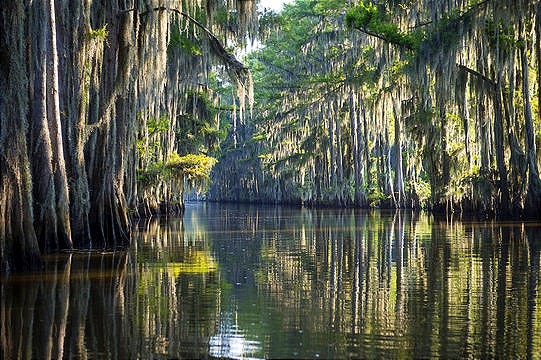“The Swamp Knows” – Louisiana’s Wetlands
C’est tout, mes amis. But down here, that’s never quite the end of the story
South Louisiana doesn’t just exist. It pulses. It breathes through the cypress knees and Spanish moss, in the call of a heron and the hum of a bee hive. And nothing holds the rhythm of this place more deeply than the swamp.
When the Acadians were exiled from Nova Scotia in the 1700s, many found sanctuary in a land both unforgiving and abundant. The Louisiana swamps offered no paved streets, no maps, no guidebooks. Just mud, water, tangled trees, and wild, blessed freedom. These new arrivals, later known as Cajuns, learned to live not on the land but with it.
What is a Swamp, Really?
Let’s clear something up. A swamp is not a marsh. A swamp is a wet forest: thick with trees, their roots flooded or soaked during the growing season. A marsh is its cousin: a sea of grass. Both are waterlogged wonders, born from Louisiana’s rainfall, river overflows, and low-lying land.
Louisiana has them in spades. From the Atchafalaya to the Pearl River Basin, from Plaquemines to Vermilion Parish, we are stitched together by swamps and marshes. They are the original highways of this land, the cradle of culture and survival.
Swamp Life: Rough, Mobile, and Sacred
The swamp never promised comfort. But it gave life to those who understood its language. Generations of fishermen lived not in houses, but in floating homes. They were, and are, called Campboats. Wooden shacks bobbing along the bayous. They had no addresses, just destinations. When the fish moved, sometimes so did the family.
Inside, moss-stuffed mattresses waited after long days on the water. A porch deck up front. A back deck with the most rustic of restrooms. The kitchen? A pot of gumbo on a butane flame and a jar of honey pulled straight from the swamp.
The Boats that Built a Culture
If you want to know a people, look at their boats.
Skiffs were rowed while standing, facing forward like a boss.
Plank pirogues slid like shadows through inches of floodwater.
Dugout pirogues, the OGs, were carved from single cypress logs by Native tribes and adopted by settlers. They floated through the thickets of time itself.
Each boat had its role. Each bore witness to a unique, intimate relationship with the land. They are still used, although updated, in many places today.
Cajun Sweetness and the Buzz of Life
Before beekeeping became big business, getting honey meant hunting wild hives. A risky, sticky, sting-filled ordeal. But the Cajuns and Creoles did it anyway. Eventually, folks turned to the Langstroth hive. It was a 1876 invention that revolutionized beekeeping without hurting the bees. (We’re sweet, but we’re not heartless.)
Today, Louisiana ranks among the top honey-producing states in the U.S. Bees are still sacred. Their hum is a hymn to sustainability, old ways, and sugar in your coffee.
More Than a Place, It’s a Living Memory
The swamp doesn’t just feed us. It raised us. It raised the gumbo pot and the fiddle bow, the two-stepping porch and the moss-draped grave. The cooking, the storytelling, the Zydeco rhythms….. everything you love about South Louisiana was forged in this wetland cradle by people from France, Africa, the Caribbean, Asia, and beyond.
We’re a cultural gumbo stirred by the current. And the swamp is our roux.
Let the Swamp Speak
This isn’t just a postcard to nature. It’s a plea. Swamps are disappearing, drained and paved over in the name of progress. But we cannot afford to forget them.
They’re not wastelands. They’re wonders.
If we protect them, they’ll keep teaching. Keep feeding. Keep holding memories for generations of moss babies to come.
C’est tout, mes amis—but let’s make sure that’s not the end.






